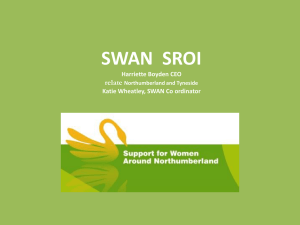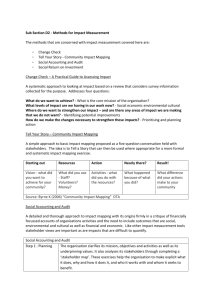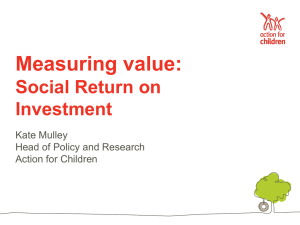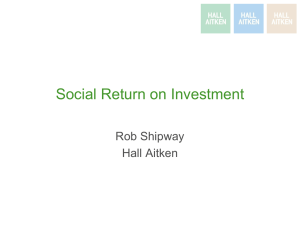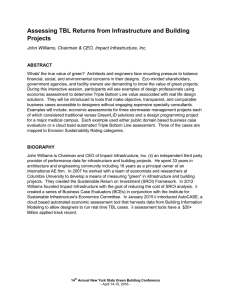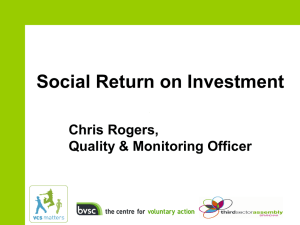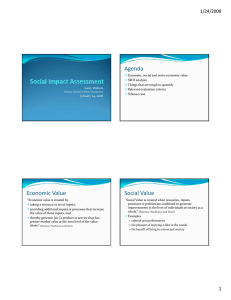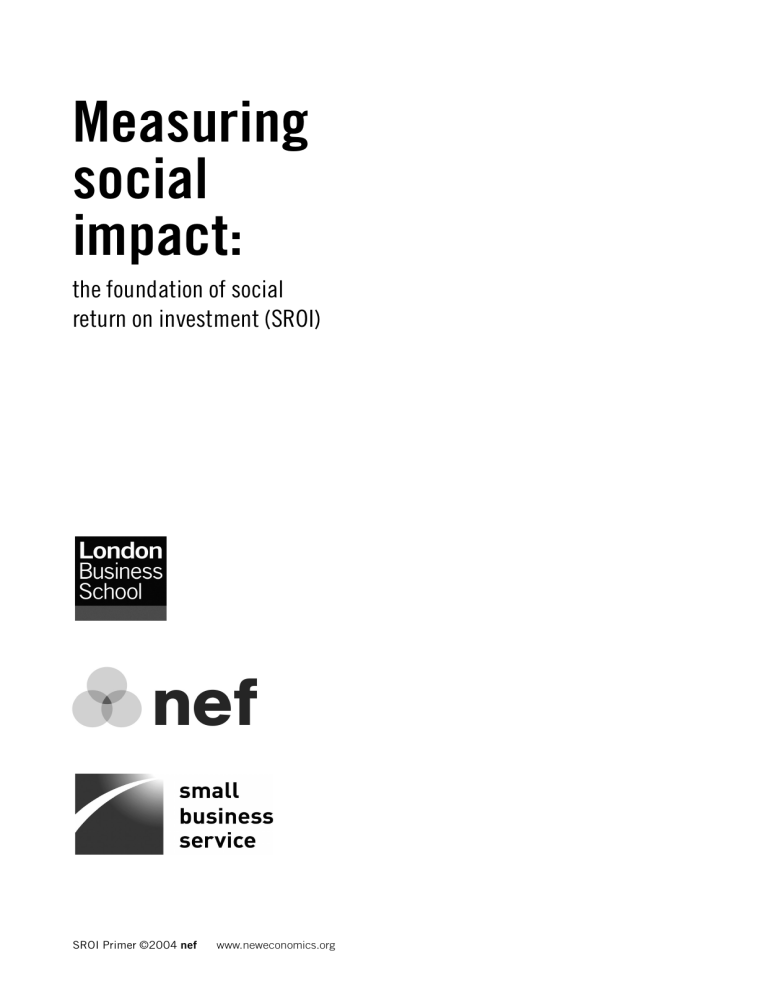
Measuring social impact: the foundation of social return on investment (SROI) SROI Primer ©2004 nef www.neweconomics.org Chapter One Introduction and Purpose Many organisations have social, environmental and economic impacts that have an effect on people, their communities and the environment for the better. They may be a social enterprise, a private business, a voluntary organisation or a government initiative. Some may be large… and others run by a very small group of people. They may work across the sectors… and can have unique objectives or they may have objectives shared by several other organisations. Essentially, to all of your stakeholders… or in other words, the people that matter to your organisation. So what links these diverse organisations? Well, they all face the same challenge… How should they measure their social outputs?… and how should they measure the value of achieving their social objectives? Now, we can often see, or at least assume the benefits of their work… but in today’s world it is necessary to communicate specific details about those benefits in order for them to be fully acknowledged. Why measure social outputs, outcomes and impact? My name is Jessica Boyd and I’m going to guide you through this introduction. We’ll be looking at measuring social outputs and valuing social outcomes in monetary terms. If you and your organisation fit into any of the categories mentioned here, then you will have everything to gain from following this process. There are two main reasons why this is important to do… Firstly, you can use the information to look forward and plan your business and its objectives… or to look back and evaluate. Knowing how well you are achieving your objectives can help you plan your organisation more effectively. It may make you more attractive to your customers and help you win contracts. Secondly, measuring and communicating the value of your social outcomes, helps to demonstrate the importance of your work to you, your staff, your customers, investors or a government agency. SROI Primer ©2004 nef www.neweconomics.org This tour will help you explore how to measure social outputs, outcomes and impact. It offers you a new, straightforward approach to assessing the monetary value of some of your social impacts. This is done by calculating the Social Return On Investment … or SROI. • Improved programme management More effective planning More effective evaluation • Increased understanding of the impact of your work • Stronger communication of the value of your work to ‘the people that matter’ (internal and external stakeholders) • Enhanced attention to the social, economic and environmental value created by your business or organisation I should also mention that we will use the word ‘social’ here as a short form for ‘social, environmental and economic’ throughout. This web tour has been designed for you to move easily from chapter to chapter. You can also jump straight to the chapter of your choice. You can download the transcript as well as the slides… and there are links to useful information on the resources page of our Web site… as well as a glossary of terms. So, before we get started, let’s hear some of the questions that different organisations are asking. 1.1 Chapter Two Ask the Right Questions “We change people’s lives for the better. How do I measure that?” “There are many different groups of people involved in or interested in someway in my organisation. All these stakeholders seem to want different things: How do I prioritise them?” “I want to bid for work on a new social housing project. They’ve asked about social benefits that are part of working with my company. What’s the right answer?” “They say that what gets measured gets valued, but how do I measure a new skill, access to employment or crime reduction?” If someone asked you about the value of your car, or a pair of jeans… you would be able to tell them. When accountants assess a business’s financial statements, they calculate its value in terms of sales or outputs, versus cost of goods and overheads. But if you produce a social output, how do you measure that value and calculate its worth? Well, many organisations are asking that same question. Some have investors interested in what will be achieved with their financial input. Some have customers choosing to buy products because of their social impact… like fair trade coffee. Some just want to be bolder about the positive role they are playing in SROI Primer ©2004 nef www.neweconomics.org society, in order to expand their programmes and increase their impact further. The reality is there are many reasons to measure your social outputs and outcomes… and there is no one way or right answer. Ask the right questions • Who are the people that matter to my business? What are their objectives? • How should I prioritise my stakeholders? Are their objectives aligned to mine? • What output indicators illustrate how well I achieve my objectives? • Can I measure the social return that results from our impact? The key is to measure what best reflects the interests of your business and the interests of your stakeholders. Before we look at how we should go about measuring social outputs and outcomes, we’re going to look at the basic four elements needed for this process. 2.1 Chapter Three Terms and Definitions There are 4 main elements needed to measure social value creation: inputs, outputs, outcomes and impacts. Now, these terms mean different things to different people, so let me clarify how they are being used here. Inputs are the resources you need in order to make something happen. They’re measured as a cost. For example, the cost of equipment for running a computer training programme. Outputs are the direct result of your business objective or programme goal. So for example, 25 people learned new computer skills as a result of your training programme. An outcome is a change that has occurred over the longer term. So for example, the number of people that started work and improved their personal circumstances as a result of the training programme. This outcome can be measured in their own terms, for example, the value of their increased income. It could be measured from the perspective of a different stakeholder… like the government. In this case, the value of the outcome would also include increased taxes paid or reduced support payments by the state. the impacts. So perhaps 2 of 20 programmers would have found jobs on their own. That means that the impact of the training programme should be calculated based on the other 18 (people) that started work. Key Terms Inputs Outputs Outcomes Impacts • Inputs - resources invested in your activity • Outputs - the direct and tangible products from the activity, i.e., people trained, trees planted, products sold • Outcomes - changes to people resulting from the activity, i.e., a new job, increased income, improved stability in life • Impact = Outcomes less an estimate of what would have happened anyway As the following real-life case studies will illustrate, all of these terms will become meaningful to you only in relation to your business objectives and to the objectives of your different stakeholders. Now, if you adjust the outcome to take into account what would have happened anyway… you identify SROI Primer ©2004 nef www.neweconomics.org 3.1 Chapter Four What Gets Measured, Gets Valued The first thing that needs to be decided in any organisation is… What outputs do we measure? Well, I’m joined by Gabin Sinclair from Ocean, an independent music venue in Hackney, East London. He’s going to tell us about their experience. Jessica Boyd: Hi Gabin, could you start by telling us a bit about Ocean? Gabin Sinclair: Well Ocean is a state of the art music venue, with the vision of contributing to Hackney’s regeneration through music. JB: So you could say that you’re helping to improve Hackney as a place to live and work. That’s a pretty big goal. GS: That’s right, but we believe that creating a vibrant music scene, one that the local community can participate in, will help regenerate that community. Getting young people involved is particularly important. JB: So, how do you go about doing this? GS: Ocean brings in musicians who otherwise wouldn’t be seen or heard live. Giving them the opportunity to perform, helps them to be noticed. We also work with other community groups who want music to be a part of their programmes. Ocean also runs Rising Tide which is our education programme with a more focused target group… most of the students on Rising Tide programmes are aged between 16 and 22. commercial music events… or the number of local artists performing at Ocean… or the number of students participating on the Rising Tide programmes. JB: That seems clear… and what does the Rising Tide programme actually entail? GS: Rising Tide provides all kinds of workshops from music performance to technical and business skills… those for working within the music industry. For example, we deliver DJ courses, vocal and instrumental training and studio or sound production What Gets Measured, Gets Valued An objective is a ‘theory of change’ Outputs measure progress towards achieving that change through an organisation’s work courses. In the short term, people gain these specific skills, but in the longer term, they become more educated and ultimately more employable… and some actually get new jobs because of this process. JB: I see, so what outputs do you actually measure? GS: Well, our outputs are the participation rates … or you could say, the number of people attending SROI Primer ©2004 nef www.neweconomics.org ... Continued 4.1 JB: That sounds great!… and have you always measured the direct outputs of Ocean’s work? GS: Two thirds of our operating revenue is from ticket sales. The remainder comes from funders who believe that music can help regenerate Hackney. Some of our funders are interested in our artistic programme. Others are interested in our education or in future skills for employment. JB: So, how do you prove to them that you’re achieving your objectives? GS: We track outputs such as participation or qualifications obtained on our courses. We track Rising Tide students who are on accredited courses more closely because this helps us to assess whether or not our courses are meeting their needs. JB: So, we can understand your outputs as the participation rates across the different aspects of Ocean’s work… but what about outcomes, how would you define those for us? GS: We’re just starting to measure our outcomes such as the value of Rising Tide to our students’ long term education… and the value to society in relation to the reduction in crime. Many of our students are referred to us by the local youth offending teams… usually in relation to anti-social behaviour. Our students get really engaged on our courses, so we can usually tell who’s behaviour changes and improves throughout the process. The police will tell you that criminal activity reduces when young people are involved in activities such as Rising Tide. JB: So we can see it makes a real impact on the local community. Now, how far, would you say, that measuring your outputs and outcomes, helps you to prove that you are achieving your objectives? GS: We’ve realised that the stories we tell are more clearly understood when they’re supported by figures. We can’t count everything, but counting what we can, makes the information more tangible to our stakeholders. SROI Primer ©2004 nef www.neweconomics.org JB: Thank you very much Gabin. So, in Ocean’s example, we’ve learned that their outputs are the numbers of participants involved in the different programmes. They’ve started to measure outcomes, such as long term education and reduced crime in the area and we’ll be looking at how we can value these social outcomes a little bit later. But first, we’re going to explore the importance of deciding which outputs and outcomes to measure from the viewpoint of your different stakeholders. What Gets Measured, Gets Valued Ocean’s theory of change: music-related activities can contribute to the regeneration of a community Outputs measured are the number (#) of: - musicians performing to local tastes - local musicians performing - people coming to music events - people enrolled in programmes - students graduating with LOCN credits What Gets Measured, Gets Valued Output Indicator Stakeholders (external) # of musicians performing to local tastes, # of local musicians Hackney Council, arts-oriented investors # of people at community and music events Community leaders, local arts and community groups, Hackney Council # of people enrolled in programmes Hackney Council, arts-oriented investors, community leaders # of students graduating with LOCN credits Hackney Council, local business Crime reduction rates Local police, community leaders, local residents 4.2 Chapter Five Value is in the Eye of the Stakeholder As Gabin explained to us, looking at your outputs can help demonstrate how well you’re meeting your objectives. JB: That’s interesting, could you tell me a bit more about your stakeholders and how you prioritise their needs? We’re now going to look at another real-life case study in order to demonstrate how important it is to know the objectives of your different stakeholders as this will lead to new sources of value creation. KL: Yes, one of the main stakeholder groups we have are the local communities that surround our woodland. They were very wary of our motives at first. It was important for us to get them on board right Karen Lowthrop is here from Hill Holt Wood, a social enterprise in Lincolnshire. Jessica Boyd: Hi Karen. Karen Lowthrop: Hi Jessica. JB: Could you give us some background on your organisation and your overall objectives? KL: Sure, Hill Holt Wood is a 14 hectare woodland which we run as a social enterprise. One of the key objectives is for us to provide training, vocational training, for 15 to 18 year olds who are at risk of social exclusion. Also, another key objective is to encourage free public access to the woodland and to give information to our local community. JB: So you run a training programme for young people at risk of social exclusion. KL: Yes, that’s part of it, but we founded the woodland because woodlands play a vital part in the health and overall wellbeing of communities. Woodlands are part of the sustainable development agenda and they do play a role in job creation and economic output. In fact we employ 14 people now and that is a significant employer in our area. SROI Primer ©2004 nef www.neweconomics.org Value is in the Eye of the Stakeholder • Identify and prioritise all your stakeholders • Consult with them (where possible) to identify common priorities • Measure progress towards achieving your objective • Understand how their objectives match or conflict with your objectives • Tell your stakeholders what you are doing well, where you could improve and your future goals from the beginning… and they have formed part of the team that has developed this social enterprise. This has helped us both with our business objectives and also in restoring the woodland. It is important for individuals and groups to take advantage of this very unique environment. ... Continued 5.1 JB: But how do you know that you have achieved that objective? JB: Would you say that your objectives have ever been out of step with a key stakeholder? KL: We track users to the woodland, and this helps us to explain the value of what we do to other stakeholders… like government departments who are involved in social development, health and the environment. It has been proved, I think, that woodlands are a very good environment for people to be in. They can dilute all sorts of stress areas and they can be very calm. Exercise and physical work also can have very good measurable benefits for health. KL: Well the young people we have on our vocational courses come with many barriers to learning. Barriers that have prevented them from going into education… or indeed, have led them into crime. Their objective for coming on the course is to get a job, to look for long term employment. Funding dictates to us that we track just the trainees, the learners that we train successfully. But the key objective is for learners and we don’t feel that we have reached that objective unless our learners have got sustainable jobs that they will stay in for some time. JB: What other issues are important to your stakeholders? KL: I think the presence of 40 people on site at Hill Holt Wood… It’s a ’lived in’ woodland… accessibility of paths… encourages a lot of… a wide variety of visitors. They feel secure in a well managed, lived in woodland. So, more people benefit from social and environmental value we are creating. JB: So we can see, therefore, how knowing stakeholder objectives is important, particularly for programme delivery. Thank you very much Karen for sharing your experience with us. KL: Thanks Jessica. JB: And could you explain to us how all this may link to vocational training? KL: That’s a good question. Our resources come from the natural woodland. We offer courses in ‘green woodworking’, construction, woodland skills and woodland management… and that’s just an example of some. Programme funding comes from government sources for ‘youth at risk’ and our classes are very small. We have four students to one instructor… and this allows us to give the kind of attention they need. SROI Primer ©2004 nef www.neweconomics.org So, with Karen’s case study in mind, we’re now going to look at how social value can be monetised… and we will introduce the Social Return On Investment analysis. 5.2 Chapter Six Social Return on Investment We’ve looked at measuring outputs and identifying outcomes in relation to the objectives of different stakeholders. We’re now going to look at monetising the value of social impacts. I’m going to hand over now to Jeremy Nicholls from the New Economics Foundation and to Stephanie Robertson... and they will introduce Social Return On Investment. Jessica Boyd: Hi Merseyside is actually in an area in Britain which has a very high rate of unemployment. That means that young people, particularly those with criminal records, have a difficult time finding jobs. Social Return on Investment Jeremy Nicholls: Hi. Stephanie Robertson: Hello. JB: So, Stephanie, what does SROI mean? SR: Many people will be familiar with the return on investment, ROI, as a way of estimating financial value creation. Generally speaking, if you invest a pound in a project, and more than a pound is returned within a reasonable time frame, that project is probably worth further consideration. Investors in organisations that create social value are thinking the same way. They might be a philanthropist , a venture capitalist… they could represent a foundation or perhaps a government department. There’s many, many different profiles. Social Return On Investment, SROI, is a way to monetise the value of the social impact in financial terms. Basically what we’re trying to do is monetise the value of the social impact of an organisation’s work. Then we’re going to compare that social value to the cost of making that project happen. We can illustrate SROI Primer ©2004 nef this by using a case study of an organisation by the name of Tomorrow’s People. We’ll look at their Get Out to Work programme in Merseyside. www.neweconomics.org • Social investors seek evidence of social impact (social return) that results from their financial investment • They have many different profiles (i.e. philanthropist, venture capitalist, foundation or government) • SROI indicates the value of the social impact in financial terms Get Out to Work was actually created to address that problem… and Tomorrow’s People works with a number of organisations in the Merseyside area. Now, Jeremy actually worked with Tomorrow’s People and he did the SROI analysis… so he’s going to talk us through. ... Continued 6.1 JN: Thanks Stephanie. Well, I’d like to start by describing the organisation’s inputs and outputs. Get Out to Work costs £51,000 a year… and it measures its success against three targets: Helping 163 of its offenders over the first 2 years… ensuring that at least 12 people get a job at the end of that… and reducing the reoffending rate for its client group. At the end of the first year, Get Out to Work had helped 110 people… and 19 of them had found work and were still employed at the end of 10 months. Now the reoffending rate was 15% lower than the national average for that target group… and it was by measuring their success against these targets, that Get Out to Work was able to calculate the SROI. This is how they did it… The input was the £51,000 invested. The outputs were the 110 people that they helped over the first year. The direct outcome was that 19 people found a job and reduced the amounts of money they needed from the government. The indirect outcome was the lower rate of reoffending. Tomorrow’s People were able to use government statistics and the results of their own surveys to estimate the value of the increase in income (to each job holder), the reduced payments from government and the lower crime related costs. They were also able to use Labour Force Survey information to estimate that, on average, 2 of the 19 people would have found work without their help… and so the value of the social impact of Get Out to Work was calculated on the basis of the outcomes for 17 people and not 19. SR: That’s a really important point. You need to distinguish between outcomes and impacts in order to make sure you don’t overstate your value. This way, your information will be more credible to your stakeholders. JN: That’s right,… and the results of the first year’s SROI Primer ©2004 nef www.neweconomics.org activity, were used to project over the next 5 years… and each future year was discounted to allow for the change in the value of money over time*. This was all added up, and resulted in a present day value of Get Out to Work of £543,000. Building Get out to Work’s SROI Inputs Outputs £51,000 110 clients involved in programme Outcomes Direct – 19 clients gain long term employment (increased wages, reduced state benefits paid) Indirect – 15% reduction in re-offending Impacts Direct – 17 clients into long term employment (deadweight accounted for) Indirect – 15% reduction in re-offending GOTW’s SROI Calculation Impact 17 clients Yr 1 Yr 2 Yr 3 Yr 4 Yr 5 Per client benefit Employment: to client £3,670 £3,830 £3,990 £4,150 £4,320 Employment: to state £8,940 £9,050 £9,150 £9,270 £9,380 Reduced re-offending £12,400 £12,400 £12,400 £12,400 £12,400 Total social benefit £419,740 £390,990 £356,820 £334,580 £311,840 GOTW share (33% of total) £138,510 £129,030 £117,750 £110,410 £102,910 Present Value (PV) of GOTW’s share (discounted @ 3.5%) £133,826 £120,451 £106,204 £96,216 £86,647 Total PV of GOTW’s share = £543,000 (*A 5-year timeframe is a standard time horizon to project return on investment.) ... Continued 6.2 So the SROI ratio shows the value of the social impact in relation to the investment required to achieve it. The value of the social impact, in this case £543,000,… divided by the investment, in this case £51,000. Using this standard calculation, the SROI ratio for Get Out to Work was 10.5 to 1. That is, for every £1 invested, £10.50 is created for society. SR: Just for emphasis, the SROI ratio is calculated by dividing the value of your social impact by the investment required to achieve that impact. What the ratio tells you… it gives you an indication of the value for society that’s created for every £1 invested. However, just remember that SROI is a way of thinking, and you may not be able to monetise everything… so it’s probably more important to monetise the things that are important to your organisation and also important to your stakeholders. So I guess there’s 2 things to remember. SROI does not have to be complicated… and also, the SROI is just a number that is one part of the story. When you give that number to your stakeholders, it’s important to put it into context with the other details of your programme. JB: Thanks Stephanie. Thanks Jeremy. GOTW’s SROI Monetary value of impact Total PV of GOTW share of discounted social benefits over 5 years £ 543,000 Investment £ SROI Ratio 51,000 10.5 : 1 For every £1 invested, £10.50 is created in benefit for society SROI = monetary value of impact / value of inputs SROI Review • The SROI ratio helps to tell your story, it is not the whole story! • Set objectives and identify output indicators • Think through outcomes. Decide which can be measured and monetised. Find data • Calculate outcome. Subtract deadweight to illustrate impact. Check your assumptions • The SROI ratio is the total monetary value of impact, divided by the investment Well that was a clear introduction to how we can use a straightforward calculation to help us evaluate our social impact. Also that SROI could be regarded as a framework for reporting on our wider impact. The SROI ratio simply indicates value created for society based on the initial investment. SROI Primer ©2004 nef www.neweconomics.org 6.3 Chapter Seven The Essentials and Further Resources “It certainly makes sense to me. I need to decide how to measure outputs against my objectives so that I can monitor how well I am achieving these.” on your objectives and the interests of your key stakeholders will help you to get the results that you need. “Ah, I see. By understanding my stakeholder’s needs, I can try and meet them through my organisation’s objectives.” We hope that you will have found this useful in developing your own measurement systems and planning how to communicate the results. “By putting myself in my stakeholder’s shoes, I can find new sources of value creation.” Go to the ‘Resources’ section of this Web site and you’ll find links to additional information on social impact measurement, valuing social outcome… and SROI. And remember that you can download the slides as a useful reference document. “This is really interesting! I’m going to include it in my next tender as it may help me win the contract.” Many organisations, from social enterprises and charities, to government departments and investors, are looking at ways to measure social outputs, outcomes and impacts. We hope that more and more of you will see the benefits of using the SROI ratio to demonstrate social value creation. Now, not everything can be monetised, but the things that can, really help to illustrate the importance of the work being done… and the value flowing from achieving social objectives. We’ve gone through the basic steps in this introduction… Firstly, set your objectives and identify what outputs you want to measure. Then think about your outcomes and decide which of these can be monetised. Then find the data necessary to do this. Calculate the value of your outcomes and subtract what would have happened anyway… this identifies the impacts. Finally, you can calculate your SROI based on your impact, divided by the investment. Although this process does take some thought, it doesn’t have to be complicated. Keeping focused SROI Primer ©2004 nef www.neweconomics.org Thank you very much for watching and good luck! The Essentials • Understand stakeholder needs and match them to your organisation’s objectives • Decide how to measure outputs against your objectives • Putting yourself in your stakeholders’ shoes can lead to new ways of understanding value creation • Report on the whole process, not just the numbers • Government statistics and other data can be used to calculate how you create social impact*. Don’t overstate what was actually achieved *Government data can help both to estimate the monetary value associated with certain impacts, and to compare the outcomes for people or groups involved with your organisation to others like them or the general population. 7.1
